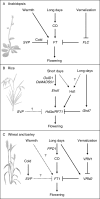The molecular biology of seasonal flowering-responses in Arabidopsis and the cereals
- PMID: 19304997
- PMCID: PMC2685306
- DOI: 10.1093/aob/mcp063
The molecular biology of seasonal flowering-responses in Arabidopsis and the cereals
Abstract
Background: In arabidopsis (Arabidopsis thaliana), FLOWERING LOCUS T (FT) and FLOWERING LOCUS C (FLC) play key roles in regulating seasonal flowering-responses to synchronize flowering with optimal conditions. FT is a promoter of flowering activated by long days and by warm conditions. FLC represses FT to delay flowering until plants experience winter.
Scope: The identification of genes controlling flowering in cereals allows comparison of the molecular pathways controlling seasonal flowering-responses in cereals with those of arabidopsis. The role of FT has been conserved between arabidopsis and cereals; FT-like genes trigger flowering in response to short days in rice or long days in temperate cereals, such as wheat (Triticum aestivum) and barley (Hordeum vulgare). Many varieties of wheat and barley require vernalization to flower but FLC-like genes have not been identified in cereals. Instead, VERNALIZATION2 (VRN2) inhibits long-day induction of FT-like1 (FT1) prior to winter. VERNALIZATION1 (VRN1) is activated by low-temperatures during winter to repress VRN2 and to allow the long-day response to occur in spring. In rice (Oryza sativa) a VRN2-like gene Ghd7, which influences grain number, plant height and heading date, represses the FT-like gene Heading date 3a (Hd3a) in long days, suggesting a broader role for VRN2-like genes in regulating day-length responses in cereals. Other genes, including Early heading date (Ehd1), Oryza sativa MADS51 (OsMADS51) and INDETERMINATE1 (OsID1) up-regulate Hd3a in short days. These genes might account for the different day-length response of rice compared with the temperate cereals. No genes homologous to VRN2, Ehd1, Ehd2 or OsMADS51 occur in arabidopsis.
Conclusions: It seems that different genes regulate FT orthologues to elicit seasonal flowering-responses in arabidopsis and the cereals. This highlights the need for more detailed study into the molecular basis of seasonal flowering-responses in cereal crops or in closely related model plants such as Brachypodium distachyon.
Figures

Similar articles
-
Interaction of photoperiod and vernalization determines flowering time of Brachypodium distachyon.Plant Physiol. 2014 Feb;164(2):694-709. doi: 10.1104/pp.113.232678. Epub 2013 Dec 19. Plant Physiol. 2014. PMID: 24357601 Free PMC article.
-
Evolution of VRN2/Ghd7-Like Genes in Vernalization-Mediated Repression of Grass Flowering.Plant Physiol. 2016 Apr;170(4):2124-35. doi: 10.1104/pp.15.01279. Epub 2016 Feb 4. Plant Physiol. 2016. PMID: 26848096 Free PMC article.
-
Integration of seasonal flowering time responses in temperate cereals.Plant Signal Behav. 2008 Aug;3(8):601-2. doi: 10.4161/psb.3.8.6352. Plant Signal Behav. 2008. PMID: 19704811 Free PMC article.
-
Molecular control of seasonal flowering in rice, arabidopsis and temperate cereals.Ann Bot. 2014 Nov;114(7):1445-58. doi: 10.1093/aob/mcu032. Epub 2014 Mar 20. Ann Bot. 2014. PMID: 24651369 Free PMC article. Review.
-
The molecular mechanism of vernalization in Arabidopsis and cereals: role of Flowering Locus C and its homologs.Physiol Plant. 2020 Nov;170(3):373-383. doi: 10.1111/ppl.13163. Epub 2020 Aug 13. Physiol Plant. 2020. PMID: 32623749 Review.
Cited by
-
Comparative Transcriptome Analysis of Early- and Late-Bolting Traits in Chinese Cabbage (Brassica rapa).Front Genet. 2021 Mar 4;12:590830. doi: 10.3389/fgene.2021.590830. eCollection 2021. Front Genet. 2021. PMID: 33747036 Free PMC article.
-
FR-H3: a new QTL to assist in the development of fall-sown barley with superior low temperature tolerance.Theor Appl Genet. 2013 Feb;126(2):335-47. doi: 10.1007/s00122-012-1982-8. Epub 2012 Oct 2. Theor Appl Genet. 2013. PMID: 23052020
-
Vernalization response of Phleum pratense and its relationships to stem lignification and floral transition.Ann Bot. 2010 Nov;106(5):697-707. doi: 10.1093/aob/mcq174. Epub 2010 Aug 26. Ann Bot. 2010. PMID: 20798263 Free PMC article.
-
Expression of FcFT1, a FLOWERING LOCUS T-like gene, is regulated by light and associated with inflorescence differentiation in fig (Ficus carica L.).BMC Plant Biol. 2013 Dec 16;13:216. doi: 10.1186/1471-2229-13-216. BMC Plant Biol. 2013. PMID: 24341499 Free PMC article.
-
The General Transcription Repressor TaDr1 Is Co-expressed With TaVrn1 and TaFT1 in Bread Wheat Under Drought.Front Genet. 2019 Feb 8;10:63. doi: 10.3389/fgene.2019.00063. eCollection 2019. Front Genet. 2019. PMID: 30800144 Free PMC article.
References
-
- Abe M, Kobayashi Y, Yamamoto S, et al. FD, a bZIP protein mediating signals from the floral pathway integrator FT at the shoot apex. Science. 2005;309:1052–1056. - PubMed
-
- An H, Roussot C, Suarez-Lopez P, et al. CONSTANS acts in the phloem to regulate a systemic signal that induces photoperiodic flowering of Arabidopsis. Development. 2004;131:3615–3626. - PubMed
-
- Appendino ML, Slafer GA. Earliness per se and its dependence upon temperature in diploid wheat lines differing in the major gene Eps-Am1 alleles. Journal of Agricultural Science. 2003;141:149–154.
-
- Beales J, Turner A, Griffiths S, Snape J, Laurie D. A pseudo-response regulator is misexpressed in the photoperiod insensitive Ppd-D1a mutant of wheat (Triticum aestivum L.) Theoretical and Applied Genetics. 2007;115:721–733. - PubMed
Publication types
MeSH terms
LinkOut - more resources
Full Text Sources
Molecular Biology Databases
Miscellaneous

